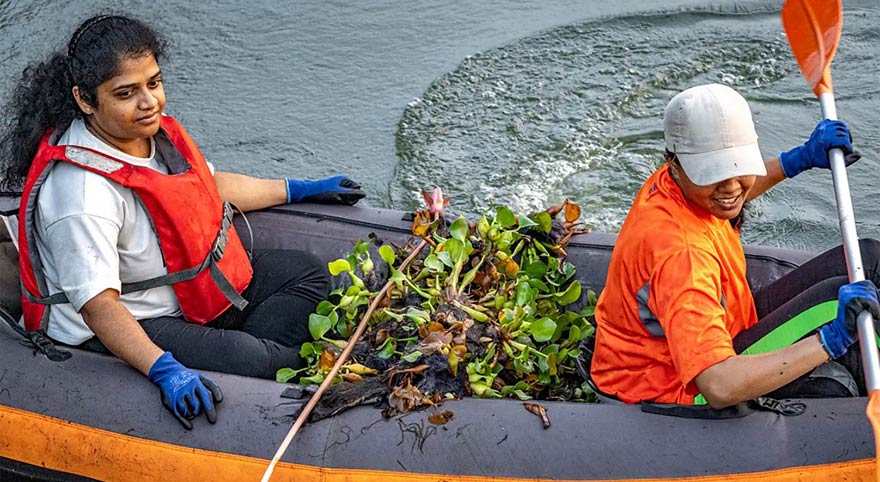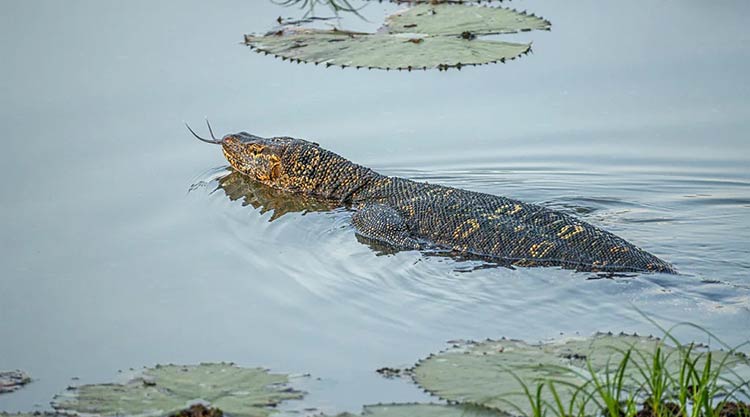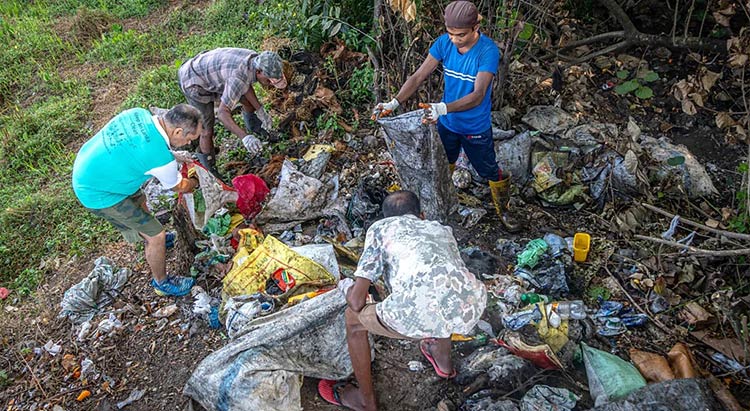Life style
The fight to save Sri Lanka’s natural flood buffers

By Zinara Rathnayake
Pay Drechsel is going for his daily morning walk around Talangama Wetland, in Sri Lanka’s capital Colombo. The sun casts a warm glow over flowering pink water lilies as a farmer scrubs down his water buffalo. A kingfisher hovers nearby. Soon, photographers will arrive to capture curved-necked egrets, waders probing for crawling worms, and little cormorants diving for freshwater fish.
Talangama Wetland and its surrounding swamps, reedbeds, canals and rice fields teem with life. But this hasn’t always been the case. About 15 years ago, these ecosystems were degraded and filled with rubbish. They were “dirty, very dirty”, says Drechsel, interim country manager at the International Water Management Institute (IWMI) in Colombo.
He recalls how he spent one Christmas almost a decade ago cleaning the lake, scouring for piles of rotting garbage leaking contaminants into the water, and sorting waste for recycling. To his surprise, passersby stopped and started helping him. “I realized it’s not only me, locals also appreciate it,” he says. “But like me over all the years, they may have been waiting for someone to take the lead.”
The community came together to keep the massive wetland complex clean, forming the Talangama Wetland Watch. Residents organize weekly collection runs, piling up sorted waste at a small collection unit which the municipality sends off for recycling. School kids volunteer, kayaking through the lake to dig up invasive water hyacinth.
Home to over two million residents, Colombo is built on and around a massive network of wetlands. In 2018, Colombo became one of the 18 Ramsar wetland cities in the world – an accreditation which recognizes cities for their commitment to restore, safeguard and value wetlands, with 25 new cities added to the list in 2022.
As Colombo is located in a river basin, the city is naturally prone to floods. Colombo’s wetlands act as a flood buffer, with 40% of floodwaters draining into wetland areas. They also sink carbon, purify the air and control temperatures. As temperatures warm and rains become more erratic, “wetlands are important to the city to mitigate climate change impacts”, says Chethika Gunasiri, an environmental scientist at the University of Tokyo who was part of Colombo’s Ramsar application. “Wetlands help Colombo mitigate pollution and natural disasters. They help reduce human stress as more and more people are now living in high rise buildings,” she adds.
Historically, wetlands were a “part and parcel of people’s lives in Colombo,” says Missaka Hettiarachchi, a senior fellow at the World Wildlife Fund’s environment and disaster management programme, who has been studying wetlands in Colombo for several years. Ancient kingdoms thrived in a well-managed wetland system where people used them for transport and to grow food, Hettiarachchi says.
Their downturn began in the British colonial period from the late 18th Century. When industries grew, people acquired wetlands to drain for building housing and businesses. A flood retention scheme introduced during British rule in 1924 led to the creation of man made drainage canals, preventing people from travelling through the wetlands. Although they are regularly cleaned, many of these canals are now polluted and choked with invasive plants.
- The restoration has boosted wildlife populations in Colombo’s wetlands
- Thalangama Wetland in Colombo used to be filled with rubbish but is now teeming with life
“The canals are no longer enough to prevent Colombo from flooding,” says Gunasiri.
After independence in 1948, subsequent governments declared some wetlands for flood buffering, and filled up others to make space for living, Hettiarachchi says. “And people thought wetlands were also a very, very attractive space for garbage dumps, because, you know, no one is living there, right?” This meant that people dumped everything from food waste to solid waste and chemicals while releasing sewage into the wetlands.
From the 1980s, massive rubbish mountains began to appear in natural wetlands, such as Meethotamulla in the Colombo metropolitan area, which spans 100,000 sq m (107,639 sq ft) and stands 60m (197 ft) tall. The wetland was closed after one of the rubbish mountains collapsed and killed 32 people in 2017.
During the civil war (1983-2009), the encroachment of wetlands continued, as they were sold to internally displaced people, Hettiarachchi says. Some marshy wetlands turned into shrub habitats that couldn’t hold enough water to protect the city from flooding, he says. According to one study, Kolonnawa Marsh, which forms the largest part of Colombo’s flood retention belt, has lost 65% of its area since the 1800s. A 2014 study concluded that 44% of the marsh has turned into a shrubland. The soil too has changed, reducing its capacity to absorb and drain water, leading to increased flooding and disasters.
By the 2000s, the city’s wetlands were “a bloody mess”, Hettiarachchi says. During his PhD, he would ask residents living near the degraded wetlands about these ecosystems, and they would respond: “No, we don’t know any wetlands.”
The decline of the wetlands made Colombo more prone to flooding. In 2010, a series of disastrous floods affected nearly 700,000 people and submerged the country’s parliament. This led to a shift in government policy. “I think it took a few significant flooding events for the government to realize, okay, wetlands are a significant flood control mechanism, so we need to do something about it,” says Radheeka Jirasinha, a freshwater and wetland management researcher at IWMI.
As part of the ongoing revival, the government introduced the metro Colombo wetland management strategy in 2016, which aims to include wetlands in urban planning, prevent further wetland loss, restore the ecosystems and involve the local community in their conservation. Following that, wetlands were incorporated into urban infrastructure by constructing cycling tracks, jogging paths and recreational areas around them.
“The idea was to bring people to the wetlands,” Gunasiri says. The government initiatives pulled up invasive species like water hyacinth and introduced new soil and wetland plants to attract birds and other animals.
Today, Colombo is home to four wetland parks and several other recreational spaces linked by wetlands. These restored wetlands look very different from those left untended. Photographer Nazly Ahmed says that when he went to Kotte, a Colombo suburb and the administrative hub of the country, in the late 1990s to play cricket with friends, the wetlands were covered entirely by water hyacinth. This invasive weed clogs waterways, grows over native plants, reduces oxygen and creates breeding grounds for mosquitoes, and their growth is linked to poor water quality and high pollution levels.
This Colombo suburb is now home to jogging paths and bird watching spots built around the wetlands and waterways. “No one knew about wetlands then, but people are talking about wetlands now,” says Ahmed.
Gunasiri says these green infrastructure projects have helped people to engage with the city’s wetlands again and that people now flock to the urban wetland parks for an evening jog. “When these natural systems become public areas, people start to have a sense of ownership,” she says.
Jirasinha agrees. People feel that they can use these spaces now, she says. “They’re concerned about what is happening. And suddenly, people look at the water and are like, ‘Hey, it’s polluted…where is that coming from’?”
It’s not only the government that is managing Colombo’s wetlands. Community initiatives like the Talangama Wetland Watch have started to take responsibility too. “If you keep wetlands free from rubbish and maintain them, they increase the property value in urban areas,” says Drechsel, who believes people are willing to pay twice as much for land with wetland views.
Although there’s an attitude shift and residents are now aware of the value the wetlands add to the city, problems are far from over, Hettiarachchi says. After the civil war ended in 2009, Colombo’s urban population expanded rapidly. Developments sprung up, leading to the draining of wetlands for housing, businesses and infrastructure. Since 2009, Colombo has lost 2.12 sq km (0.8 sq miles) of its wetlands.
According to a 2024 study, wetlands absorb 62.1mm more floodwater than built up areas in Colombo. Despite collective efforts to clean and restore some of the city’s wetlands, the overall loss of wetland area means that Colombo is becoming more vulnerable to floods, the 2024 study notes.
The Ramsar accreditation pushed the state government to temporarily suspend filling and destroying any wetlands. “So there’s definitely proactive action to safeguard the city’s wetlands, but we need a coordinated effort from government, non-profits and communities to stop their degradation,” says Chaturangi Wickramaratne, a freshwater ecologist at IWMI.
Gunasiri explains that wetland education is vital for citizens to understand their importance in urban resilience. “More and more wetlands need to be a part of the city’s functions, linked to people’s well-being, so people begin to care about them more,” she says.
Wetlands can also help with the city’s food shortages, says Hettiarachchi. “You don’t need irrigation systems to grow food, you can use these ecosystems – they are also fabulous breeding grounds for fish,” he says.
Behind the new use of Colombo’s wetlands for people’s well-being, Gunasiri notes an underlying urgency to protect these ecosystems. “If we lose our wetlands, Colombo will be unliveable.
“BBC”
Life style
Elevating Sri Lanka’s standing in global luxury events

Anantara Peace Haven Tangalle Bungalow
 The grand opening of Peace Haven Bungalow at Anantara Peace Haven Tangalle was celebrated with an unforgettable evening of opera. Guests were serenaded by internationally renowned talents including Concert Pianist Jean-Marc Pont Marchesi from Paris, Soprano Chrisni Mendis from Rome and Sri Lanka, and Russian Tenor Sergei Radchenko. These acclaimed artists were joined by celebrated local performers Indika Upamali and Subuddhi Lakmali, supported by Sanithi Dias, Manoj Sanjeewa, Madhava Bandara, Tusith Simpson, and Anosh Ismail. Anantara Peace Haven Tangalle Resort, part of Minor Hotels,recently the resort’s most exclusive and luxurious event venue to date. It was a grand evening of glitz,glamour and entertainment.
The grand opening of Peace Haven Bungalow at Anantara Peace Haven Tangalle was celebrated with an unforgettable evening of opera. Guests were serenaded by internationally renowned talents including Concert Pianist Jean-Marc Pont Marchesi from Paris, Soprano Chrisni Mendis from Rome and Sri Lanka, and Russian Tenor Sergei Radchenko. These acclaimed artists were joined by celebrated local performers Indika Upamali and Subuddhi Lakmali, supported by Sanithi Dias, Manoj Sanjeewa, Madhava Bandara, Tusith Simpson, and Anosh Ismail. Anantara Peace Haven Tangalle Resort, part of Minor Hotels,recently the resort’s most exclusive and luxurious event venue to date. It was a grand evening of glitz,glamour and entertainment.
Nestled along Sri Lanka’s breathtaking southern coastline, Peace Haven Bungalow offers a stunning canvas for elegant weddings, private occasions, and high-end MICE events, blending timeless elegance with signature Anantara hospitality.
Perched on a cliff with panoramic views of the Indian Ocean, this bungalow offers a unique setting for up to 200 guests. As the only venue of its kind along Sri Lanka’s southern coast, it answers the growing demand for world-class luxury event spaces in the region with bespoke event planning and immersive culinary experiences.
Following the magnificent performance, guests enjoyed a lavish dinner and wine pairing experience, all set against the stunning backdrop of the Indian Ocean.
“This evening marks the beginning of an extraordinary journey for Peace Haven Bungalow,” said Erik Billgren, General Manager of Anantara Peace Haven Tangalle Resort. “This venue is not just a space; it’s a catalyst for change in how we envision luxury celebrations, stories, and moments. Our signature Anantara hospitality is geared to uniquely cater to each guest from this stunning vantage point on Sri Lanka’s southern coast.”
The creation of Peace Haven Bungalow represents a shared vision with Hemas Holdings PLC, a partnership that harmoniously combines heritage, innovation, and a deep appreciation for Sri Lanka’s natural beauty. Offering panoramic ocean views, impeccable design, and tailored service, the venue is poised to set a new benchmark for premier events in Sri Lanka and beyond.
Anantara Peace Haven Tangalle Resort is set within a 22-acre coconut plantation, The resort is the only property in Tangalle situated on a rocky outcrop, offering a secluded and scenic retreat along Sri Lanka’s rugged southern coastline. The resort features 152 rooms and villas, including 14 Garden Pool Villas, 10 Ocean View Pool Villas, six Beach Pool Villas, and two -bedroom garden pool villas.
- Arrival of Ranil Wickremesinghe and Maithree Wickramasinghe
- Barbara Segal and Hemant Dadlani
- General Manager of Anantara Peace Haven Tangalle Resort – Erik Billgren addresses the gathering
- (L to R) Tasneem Moosajee, Shyamalee Tudawe, Kishore Reddy, Champika De Silva and two other guests of the event
- Dinner followed by the Opera event
- The team who performed at the Opera event
- Event setup
Life style
Glamour and elegance Illuminate Songkran Celebration

Cinnamon Lakeside , the epitome of luxury and refined hospitality hosted a spectacular two-day dining experience at its acclaimed Royal Thai Restaurant to commemorate Songkran, the cherished Thai New Year Festival,recently
This exclusive event was graced by the esteemed presence of ambassadors, high-profile media representatives, dignitaries, and distinguished guests who gathered to immerse themselves in a sumptuous celebration of Thai culture and cuisine. Kamal Munasinghe, Area Vice President, warmly welcomed attendees, setting a tone of elegance and cultural reverence.
The evenings unfolded in a spectacular tapestry of flavours and traditions, masterfully curated by the culinary team of The Royal Thai Restaurant. Guests were delighted by an exquisite menu, reflecting authentic Thai culinary artistry, presented with flawless sophistication and meticulous attention to detail.
The vibrant ambiance was accentuated by opulent décor reflecting the essence of Songkran. Guests were enchanted by captivating traditional Thai performances and authentic rituals that beautifully symbolized the renewal and prosperity at the heart of Songkran.
Cinnamon Lakeside Colombo continues to be celebrated as a beacon of glamour and hospitality, curating unforgettable experiences that blend rich cultural traditions with modern elegance.
Pix by Darmasena Welipitiya
Life style
“Walk to Equality”

“Walk to Equality” – A Fashion Show Celebrating Life Without Labels was held recently, media representatives and distinguished guests gathered at Cinnamon Grand Colombo for the official press conference of the Walk to Equality fashion show It was an inspiring initiative presented by The Walk Model Academy in partnership with Cinnamon Grand Colombo. With the powerful tagline “Life Without Labels,” this event aims to redefine fashion by championing inclusivity, diversity, and empowerment.
Set to take place on May 19th, the Walk to Equality fashion show will feature a groundbreaking lineup of models, highlighting their confidence and individuality on the runway. This bold move challenges conventional beauty standards while providing a platform for often underrepresented voices in the fashion world.
The press conference offered a heartfelt look into the mission behind the show and the stories of the individuals involved. Organizers emphasized the transformative nature of the initiative—not just as a show, but as a movement. With a strong focus on social impact, the event seeks to promote empathy, equality, and acceptance through the universal language of fashion.
Collaborating closely with the Equality team and a host of creative partners, the show has become a beacon of what’s possible when communities unite for a common cause. The behind-the-scenes journey, from training to fittings, has been designed to uplift and empower each model, making the event more than just a moment on the runway—it’s a celebration of strength and self-expression.
Tickets for the Walk to Equality fashion show are now available for purchase online, with proceeds going toward the Meals on Wheels charitable cause, supporting rural children in need. Those interested in attending, contributing, or simply spreading awareness are encouraged to visit our social media channels for updates, ticket information, or to become a well-wisher for this important initiative.
The Academy extended thier deepest gratitude to all who have helped bring this vision to life. They shared a special thank you to Cinnamon Grand Colombo, title and hospitality partner, for their continued belief in the power of inclusion. They extended thier thanks for all their generous sponsors for thier support and help
Together, we walk toward a world where every life is valued, and every person is seen—a life without labels sums up thier motto
-

 News7 days ago
News7 days agoJapan-funded anti-corruption project launched again
-

 News7 days ago
News7 days agoSethmi Premadasa youngest Sri Lankan to perform at world-renowned Musikverein in Vienna
-

 Sports6 days ago
Sports6 days agoOTRFU Beach Tag Rugby Carnival on 24th May at Port City Colombo
-

 News4 days ago
News4 days agoRanil’s Chief Security Officer transferred to KKS
-

 Business7 days ago
Business7 days agoNational Savings Bank appoints Ajith Akmeemana,Chief Financial Officer
-

 Opinion2 days ago
Opinion2 days agoRemembering Dr. Samuel Mathew: A Heart that Healed Countless Lives
-

 Features5 days ago
Features5 days agoThe Broken Promise of the Lankan Cinema: Asoka & Swarna’s Thrilling-Melodrama – Part IV
-

 Features6 days ago
Features6 days agoTrump tariffs and their effect on world trade and economy with particular































